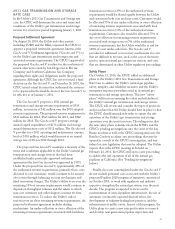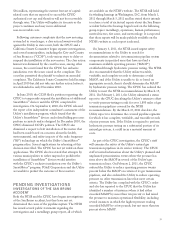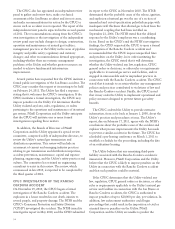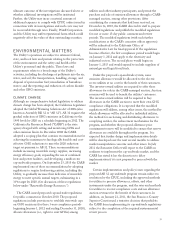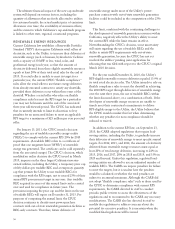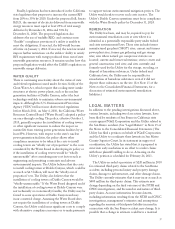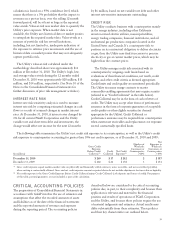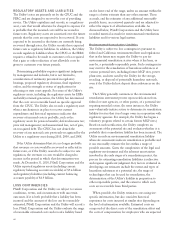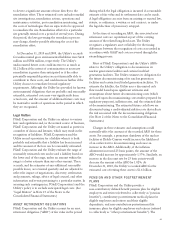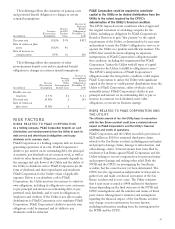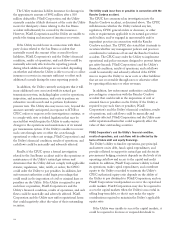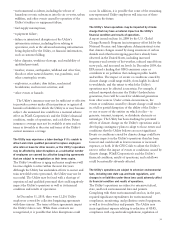PG&E 2010 Annual Report Download - page 45
Download and view the complete annual report
Please find page 45 of the 2010 PG&E annual report below. You can navigate through the pages in the report by either clicking on the pages listed below, or by using the keyword search tool below to find specific information within the annual report.to devote a significant amount of time directly to the
remediation effort. These estimated costs include remedial
site investigations, remediation actions, operations and
maintenance activities, post remediation monitoring, and
the costs of technologies that are expected to be approved
to remediate the site. Remediation efforts for a particular
site generally extend over a period of several years. During
this period, the laws governing the remediation process
may change, thereby possibly affecting the cost of the
remediation effort.
At December 31, 2010 and 2009, the Utility’s accruals
for undiscounted gross environmental liabilities were $612
million and $586 million, respectively. The Utility’s
undiscounted future costs could increase to as much as
$1.2 billion if the extent of contamination or necessary
remediation is greater than anticipated or if the other
potentially responsible parties are not financially able to
contribute to these costs, and could increase further if the
Utility chooses to remediate beyond regulatory
requirements. Although the Utility has provided for known
environmental obligations that are probable and reasonably
estimable, estimated costs may vary significantly from
actual costs, and the amount of additional future costs may
be material to results of operations in the period in which
they are recognized.
Legal Matters
PG&E Corporation and the Utility are subject to various
laws and regulations and, in the normal course of business,
PG&E Corporation and the Utility are named as parties in
a number of claims and lawsuits, which may result in the
recognition of liabilities. PG&E Corporation and the
Utility record a provision for a liability when it is both
probable and estimable that a liability has been incurred
and the amount of the loss can be reasonably estimated.
PG&E Corporation and the Utility evaluate the range of
reasonably estimated costs and record a liability based on
the lower end of the range, unless an amount within the
range is a better estimate than any other amount. These
accruals, and the estimates of any additional reasonably
possible losses, are reviewed quarterly and are adjusted to
reflect the impact of negotiations, discovery, settlements
and payments, rulings, advice of legal counsel, and other
information and events pertaining to a particular matter. In
assessing such contingencies, PG&E Corporation’s and the
Utility’s policy is to exclude anticipated legal costs. (See
“Legal Matters” in Note 15 of the Notes to the
Consolidated Financial Statements.)
ASSET RETIREMENT OBLIGATIONS
PG&E Corporation and the Utility account for an asset
retirement obligation (“ARO”) at fair value in the period
during which the legal obligation is incurred if a reasonable
estimate of fair value and its settlement date can be made.
A legal obligation can arise from an existing or enacted law,
statute, or ordinance; a written or oral contract; or under
the legal doctrine of promissory estoppel.
At the time of recording an ARO, the associated asset
retirement costs are capitalized as part of the carrying
amount of the related long-lived asset. The Utility
recognizes a regulatory asset or liability for the timing
differences between the recognition of costs as recorded in
accordance with GAAP and costs recovered through the
ratemaking process.
Most of PG&E Corporation’s and the Utility’s AROs
relate to the Utility’s obligation to decommission its
nuclear generation facilities and certain fossil-fuel
generation facilities. The Utility estimates its obligation for
the future decommissioning of its nuclear generation
facilities and certain fossil fueled generation facilities. To
estimate the liability, the Utility uses a discounted cash
flow model based upon significant estimates and
assumptions about future decommissioning costs (which
are based upon decommissioning costs studies prepared for
regulatory purposes), inflation rates, and the estimated date
of decommissioning. The estimated future cash flows are
discounted using a credit-adjusted risk-free rate that reflects
the risk associated with the decommissioning obligation.
(See Note 2 of the Notes to the Consolidated Financial
Statements.)
Changes in these estimates and assumptions could
materially affect the amount of the recorded ARO for these
assets. For example, a premature shutdown of the nuclear
facilities at Diablo Canyon would increase the likelihood
of an earlier start to decommissioning and cause an
increase in the ARO. Additionally, if the inflation
adjustment increased 25 basis points, the amount of the
ARO would increase by approximately 1.37%. Similarly, an
increase in the discount rate by 25 basis points would
decrease the amount of the ARO by 1.02%. At
December 31, 2010, the Utility’s recorded ARO for the
estimated cost of retiring these assets is $1.6 billion.
PENSION AND OTHER POSTRETIREMENT
PLANS
PG&E Corporation and the Utility provide a
non-contributory defined benefit pension plan for eligible
employees and retirees (referred to collectively as “pension
benefits”), contributory postretirement medical plans for
eligible employees and retirees and their eligible
dependents, and non-contributory postretirement life
insurance plans for eligible employees and retirees (referred
to collectively as “other postretirement benefits”). The
41


